Top Pick for
Overall VR headset

Top Pick for
Overall VR headset

Top Pick for
Budget VR headset

Top Pick for
Premium VR headset

Top Pick for
Mid-tier VR headset

VR headsets have slowly been integrating into the gaming world over the past few years. While initially there were few options, all of which were quite expensive, there are now plenty of choices. Whether you're looking to play VR games on a PC, console or on your phone, these are the best VR headsets you can get in Australia right now.
Our editorial team selected the products on this list based on our own experience using these products, joined with extensive research and real customer reviews. For each category, we carefully selected parameters based on our research and identified the products with the highest review score within those parameters.
Read more detail on our methodology below.
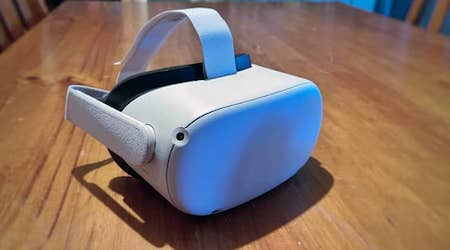
The Meta Quest 2 (formerly Oculus Quest 2) used to cost $479 for the 128GB Standard Edition. That price has since ballooned to a far less palatable $629.99. Despite a premium of $151, the hardware remains identical. (The only extra you get is the rhythm VR game Beat Saber which hardly justifies the price hike.)
Nevertheless, this is still our pick for best overall VR headset. It remains significantly cheaper than HTC's offerings which cost up to $1,699.
In addition to being a fantastic standalone VR headset, the Meta Quest 2 has some big improvements on the original Oculus Quest. It has 1832x1920 pixels per eye (up from 1440x1600) and a 90Hz refresh rate (up from 72Hz).
It isn't as powerful as more premium VR headsets, but most of those require a beefy gaming PC to operate. In any event, the Quest 2 can be given a bit more grunt via the "Quest Link" function, which allows you to tether it to a PC, which then lets you play more graphically demanding games, making the experience more comparable with the high-end Oculus Rift S (which has since been discontinued).
For more information, check out our full review of the Oculus Quest 2.
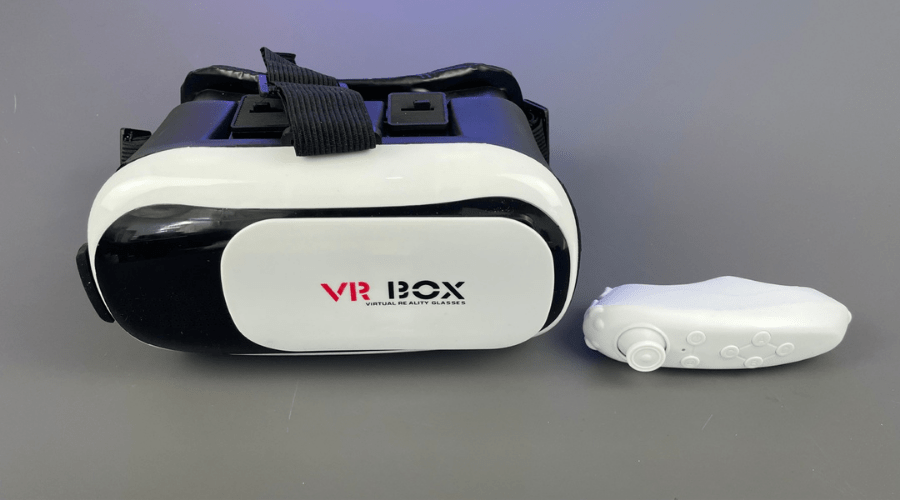
If you want to experience VR on the cheap, then using your smartphone as the CPU and screen is the way to go. You no doubt remember Google Cardboard – which became Google Daydream – that did smartphone VR with deft simplicity. However, that device has been cancelled.
With smartphone VR headsets, the heavy lifting is all done by your phone and the apps you have installed. As such, there is no shortage of smartphone VR headset options to choose from that cost between $20 and $100 on Amazon and eBay. They all do a decent job, with review scores impacted simply because people expect a premium experience despite the price.
We've given the VR Box 2.0 the nod over the rest of the smartphone VR headsets for a couple of reasons. It's on the cheaper end for starters at around $30. It's got a head strap, so your arms don't get tired since you don't need to hold it to your face. It's widely available. It can take phones 3.5 to 6.1 inches in size. There's even an IPD dial (range 58mm to 72mm) and a healthy 95-degree field of view.
Perhaps more importantly, it comes with a Bluetooth controller and some well-thought-out design quirks. For example, a vent on the side allows you to access your headphone jack/lightning port. And a slide on the front can expose your camera for passthrough.
Smartphone VR does provide a surprisingly revealing and tantalising approximation of the real deal. You can't play the big-budget, high-profile VR games on it, but there are a number of interesting experiences available for free on the various app stores that will at least give you a decent idea of what the more expensive headsets are capable of.
It's worth mentioning that you aren't going to get a stellar experience compared to "proper VR" headsets. Case in point, we gave this just 2.5 stars in our review. However, all similar headsets at this price point are going to be far from great. So if you want a stellar experience, maybe steer clear. But at $30, it's a good deal if you're dipping your toes in the water and are curious about the space.
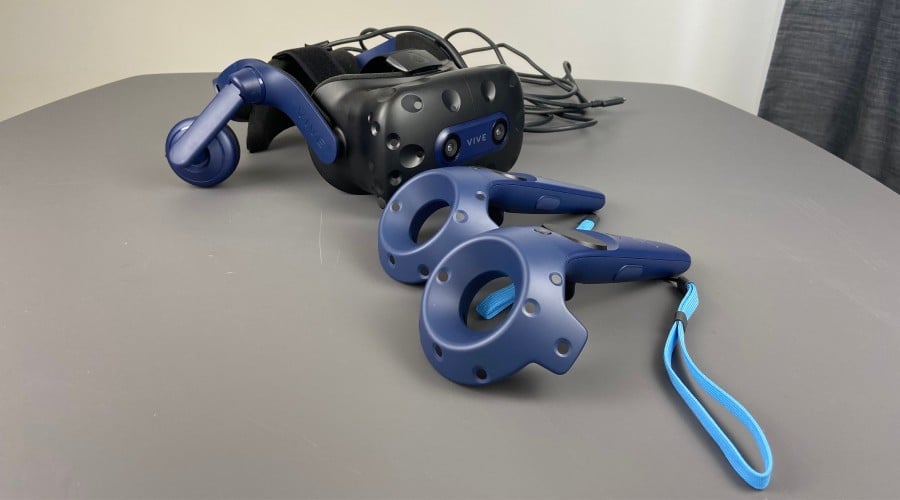
If you want the best VR headset in Australia and price is no object, the HTC Vive Pro 2 is where it's at. It offers a best-in-class combination of resolution, field of view and refresh rate. The headset is well designed for comfort thanks to its padding and has easy-to-access dials and a balanced display. The onboard audio is surprisingly adjustable and immersive.
With access to both VIVEPORT and SteamVR, you've got pretty much all the best games and experiences to choose from. And the headset works with all the Vive ecosystem accessories, including the Wireless Adaptor and the Facial Tracker. Of course, you pay for all this – premium wouldn't be premium if it wasn't also expensive.
It's not all it could be, however. It still relies on the Base Stations and the old Wand controllers, which have terrible battery life. It's also still hampered by a complex set-up for room-scale VR. Plus, you're better off using the Valve Index controllers instead of the Wands since they have finger tracking.

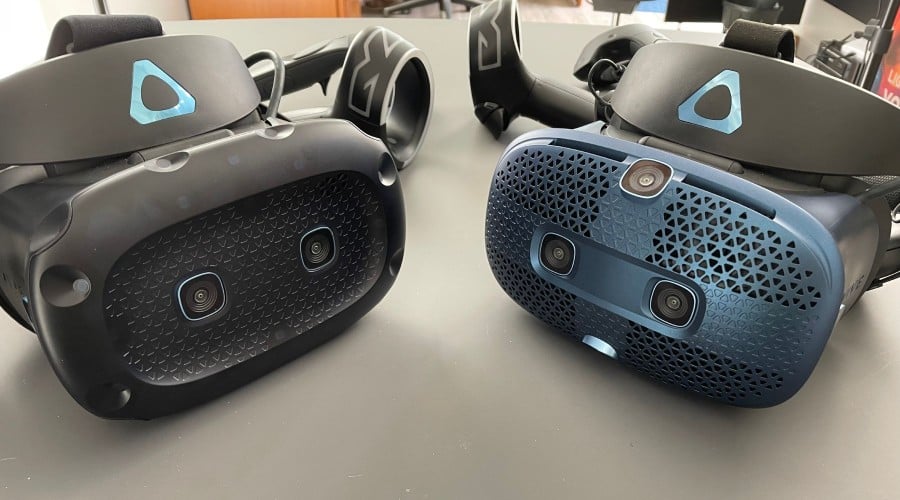
If you want a wireless full-room standing VR set-up and are willing to sacrifice both the money and a not insubstantial portion of your living space, the Vive Cosmos Elite is the premium wireless high-end option available in Australia (though if you can manage to import a Valve Index headset from a reseller, consider doing that instead).
The Elite version of the Cosmos utilises external trackers, combined with handheld "wands", to capture your movements as you wander around a 3.5x3.5 metre play space, free to interact with your surroundings in whatever ways the software allows. It's a different, more immersive way of experiencing VR than the seated options, but it does require a significant set-up and a decent amount of space in your home.
Under the hood, it packs an impressive punch: the 2880x1700 overall resolution, 90Hz refresh rate and 110-degree field of view are top-of-class specs. The flip-up screen, which allows you to switch between virtual reality and actual reality in an instant, is also more practical and helpful than you'd imagine without having experienced it – few things are more disconcerting than not being able to quickly work out what just brushed past your arm while you're in VR.
There are more convenient, better value options available, but if you want to experience the VR effect in its most powerful and convincing form – standing, without a wire and powered by a high-end PC – this is a solid choice.

Despite a recent price hike (see above), the Meta Quest 2 is far and away the best standalone VR headset. It sits on 4.8 stars from more than 23,000 Google reviews and has secured multiple accolades from professional critics.
Quest headsets are as close as VR gets to being convenient: no wires and clutter, no cameras to configure and no expensive PCs or consoles to maintain. This might seem like a trivial concern, but, speaking from a lot of personal experience, the single biggest barrier to using VR regularly is the hassle of setting it up each night.

If you're purely into virtual reality for the gaming experience, then Sony has delivered in spades with its second headset, PSVR 2. Having used all of the headsets on this page, it's no throwaway comment to say that my mind was blown the first time I fired up a game on PSVR 2.
The resolution, field-of-view and clarity is as good as it gets. Full immersion, especially with the included earbuds.
This is a feature-rich headset that ticks off everything you might expect from a 2023 VR headset. You've got eye tracking, finger tracking, foveated rendering, 4 on-board cameras, pass-through and a simplified single cord connection. Plus, it adds in Haptic Feedback and Adaptive Triggers into the mix, 2 Sony-unique innovations.
It's comfortable, too. And considering there's a grander focus here on full-blooded game experiences from major series like Resident Evil, Gran Turismo, Horizon and No Man's Sky, it's well-placed for extended gaming sessions.
It's for these reasons we believe PSVR 2 to be the best gaming VR headset you can buy, but there is a catch. It only runs with a PlayStation 5 console; there is no PCVR or WiFi6e support for other platforms. At least it's cheaper to buy a PS5 and PSVR 2 headset than it is to get the alternative premium PCVR headsets.

HTC consistently delivers quality high-end VR headsets, and the Focus 3 is not only home to a comfortable design, but to top-of-the-line specs as well. Its dual 2.5K lenses and 120-degree field of view were as good as it got when it was released in June 2021. And while the 90Hz refresh rate isn't stunning, it's still very solid.
The headset is also completely wireless and therefore doesn't require a high-end PC to run. The new controllers also have great battery life and excellent inside-out tracking. These aspects make it flexible for businesses that want to use VR on show floors, meetings or to train staff. It's a cinch to set up, too, and can be deconstructed easily for cleaning between users.
But the main reason why the HTC Vive Focus 3 gets our nod as the best business/enterprise VR headset is because of the backend support it offers companies. It comes with a 6-month subscription to the XR Suite on VIVEPORT, which has tons of business-orientated apps. For example, you can get Vive Sync for VR group teleconferencing.
You also get Android Enterprise MDM compatibility so your IT can manage multiple headsets as well as 2 years of Vive Enterprise Business Warranty and Service. And you can get onboard data encryption so sensitive information isn't lost to the Net.


Despite the 2-year gap between the Valve Index and the HTC Vive Pro 2, it's a split hair between which is the better of the 2 premium headsets. We gave the nod to the Pro 2 in that category because it has the edge in specs, comfort and accessories, but the Valve Index most certainly holds its own. You can see the video below for a more comprehensive analysis.
But on which one has the better controllers, it's a lay down misère for the Valve Index. Unique to the VR headset space, the so-called knuckles controller has a strap that binds your hand to its grip in such a way you don't need to hold it hard. Buttons and a thumb touchpad are all easy to reach and use, too.
The winning feature, however, is finger tracking. Each individual finger is tracked, allowing you to interact with games in a whole new way. It adds up to a more immersive experience. For example, in music games, you can play individual notes. And in online shooters, you can flip the bird at an opponent.
Interestingly, while the full Valve Index kit is the cheapest way to get and play with these controllers, the knuckles will work with HTC Vive headsets, too. If you have the financial means, you can buy an HTC Vive Pro 2 and play it with the Valve Index controllers.


HTC has done a fine job with Vive Flow not just converting its premium headset experience into a form factor more akin to smart glasses but also setting a new bar for what is possible with mobile VR. The Vive Flow uses your mobile phone as its CPU and as your controller. It also curates the apps through its Viveport storefront, meaning you get experiences that work and are held to a high standard.
This is certainly not the case with VR experiences you can find on the App Store or Google Play.
For the most part, the Vive Flow works really well. It's robustly built, extremely portable and streams experiences over Wi-Fi to the dual 2.1-inch 1600x1600 lenses without issue. And as mentioned, these are proper VR apps, not "a taste of VR": fully realised 3D gaming worlds, robust health and social experiences, useful business apps and more.
But it's also HTC's first attempt at this kind of device, which means it's not only expensive but there's clear room for improvement. These include the tracking of the phone controller, phone compatibility, light bleed and the somewhat dated lenses.

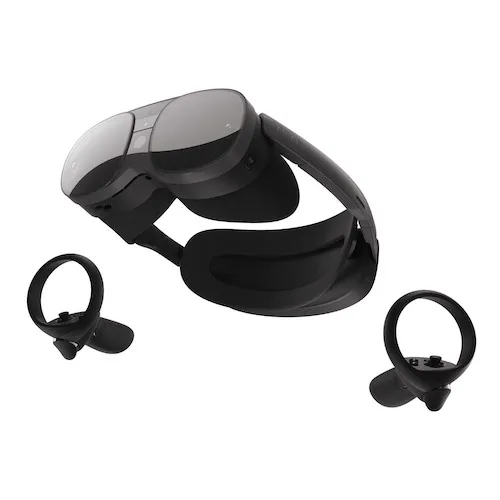
With the Vive XR Elite, HTC has taken a mix of ideas and successfully squished them into one excellent headset. You've got the best tech from its business-orientated Vive Focus 3 headset and its premium HTC Vive Pro 2, all delivered in a form-factor similar to its experimental HTC Vive Flow smart glasses alternative.
The headset is light and very comfortable, and blessed with a top-tier build quality. We're particularly impressed by how well it restricts light bleed, and the flexibility of being able to wear it in just glasses form if desired.
The visual experience is also brilliant. This is one of the sharpest VR headsets on the market, with video games and experiences looking incredible. We don't feel like the advertised field-of-view is delivered on consistently, with something of a periscope effect to the viewing area. But you'll still be blown away.
The inbuilt speakers do a solid job, but for ultimate immersion you're better off pairing a Bluetooth headset.
Setup is much easier that older HTC headsets as improvements to the app make it much simpler. The software is also very good now at allowing you to set-up your play space. While the headset uses inside-out tracking to do away with the old base stations altogether. The upgraded Focus 3 controllers track very well, as does hand-tracking. And the pass-through camera also works a treat, giving you a colour outside view with ease.
The HTC Vive XR Elite allows you to play wired or wirelessly over your home Wi-Fi, using your PC to run software. This means you can play any PCVR games, as well as mobile VR games and augmented reality experiences. It's quite the hybrid.
It's not perfect though. We did encounter too many issues getting everything to work together nicely. There are too many apps you need to have running and talking together nicely, at once. And the headset glitches out every so often, requiring a reset. But when it's working, it's one of the best experiences you can have in VR. If you can afford it!
 Temu
Temu
Temu: Up to 47% off VR headsets
Score huge savings on VR headsets at Temu. T&Cs apply.
 eBay Australia
eBay Australia
Up to 26% off VR headsets at eBay
Enjoy up to 26% off selected VR headsets at eBay. Hurry while stocks last. T&Cs apply.
Our editorial team has extensive professional and personal experience with the virtual-reality medium. We also read through hundreds of user reviewers for VR headsets available in Australia and compared them with professional reviews.
We then carefully researched each product and compared costs to establish value propositions.
For the budget category, headsets cheaper than $100 were considered. The premium categories had no price ceiling.
2022 is set to be a huge year in VR as we're on the cusp of some big innovations that can really take the tech forward.
As we've already seen with the Varjo Aero, foveated rendering and eye tracking are bringing a whole new standard to what gamers can expect. We should also start to see OLED screens become the preferred choice as well as finger tracking in all newly released controllers. Better inside-out tracking should allow us to do away with cumbersome base station set-ups, too.
We're also hopeful that the proliferation of Wi-Fi 6E chips and improvements to display stream compression will see more functional wireless experiences on premium PCVR headsets. Cutting the cord would be oh so lovely.
The reason why we have chosen PSVR 2 as our most anticipated best VR headset for 2022 is two-fold. We've already seen the controllers, which not only deliver finger tracking but also haptic feedback and adaptive triggers. But the power of the PlayStation 5 also promises to offer a super high-end VR experience for consumers that don't own a super high-end PC. Not to mention there will be a host of big-name Sony experiences that will be exclusive to PSVR 2.
Unfortunately, Australians haven't had quite the same luxury of choice on VR headsets as our overseas compatriots – or at least accessible choice. There are some VR headsets you can import from overseas that offer very compelling experiences if you're patient and cashed-up.
It's always worth doing your research but at the end of 2021, one such headset that stands out – the Varjo Aero VR headset. It's a beast.
The base specifications are right up there with the best of them, including dual mini LED LCD 2880 x 2760 pixel screens calibrated to 150 nits of brightness, a 90Hz refresh rate and a 115-degree field of view. It's pretty much edge-to-edge clarity on this device, too. And it also offers eye tracking, so it not only knows exactly where you are looking but can also automatically adjust the IDP range to suit your eyes. The result? Perfect focus.
The Varjo Aero also delivers foveated rendering, which means wherever you look, the image will be in focus. This allows the software to not waste resources making sections of the experience you're not looking at crystal clear, in turn reducing the minimum specs of the PC you require.
Add a nice design, which includes 3 different adjustment dials and full support for SteamVR, Valve Index controllers and the Vive Base Stations, and you have a real winner. Only its weight and loud cooling fan smirch the end result.
Just expect to pay a bit. And as of the time of writing, the official store won't sell to Australians, so you may have to buy through a third party.
Keep an eye on Finder for more details as they emerge.

When choosing a VR headset, consider the following factors.
Choosing between seated VR and room-scale VR will have a huge impact on your experience. With seated VR, you're confined to a chair while wearing the headset. Your head movement is tracked and reproduced on-screen, but locomotion (i.e. the movement of your in-game character through the digital world) is handled using a controller. Seated VR is typically cheaper.
With room-scale VR, multiple cameras are set up around the play area. These track your body's position, allowing you to walk, jump or even dance and have that motion reproduced in the game. It's more expensive and can be impractical for a lot of homes because it requires a somewhat empty, dedicated room.
Standalone VR has only recently hit the market, so most VR headsets need another device to power them. In the case of Oculus Rift or HTC Vive, you'll need a powerful PC with a beefy graphics card. PSVR runs on the PlayStation 4, while Google's entry-level Cardboard headsets use your mobile phone. It's worth factoring these devices into your cost equations if you need to pick up extra hardware.
The resolution of VR headsets, like televisions, is measured in pixels. Because the screen inside a VR headset is situated so close to your eyes, lower resolutions are particularly noticeable. You'll see the gaps between pixels prominently, a visual phenomenon called the "screen door effect". Higher resolutions are always better.
When comparing VR headsets, consider the relative pixel counts of devices. Just be cautious: some manufacturers list the "per eye" resolution while others list the combined resolution. If one model seems like it's double the resolution of another, it's almost certainly using the combined measure.
A lot of VR games are platform exclusives, meaning you'll need to check carefully that the one you're interested in actually works on your platform. As an example, Star Wars: Vader Immortal is only available on Oculus Rift, while Resident Evil VII can only be played in VR on PSVR.
Refresh rate is measured in Hz and determines how many frames are displayed per second. Faster refresh rates create smoother motion without flickering between frames and can even help reduce VR sickness. It's worth remembering that even though the VIVE Pro 2 and PSVR are capable of hitting 120Hzs, you'll still need a PC capable of outputting at that frame rate.
Field of view is super important, as it defines how much of the world you're exploring you can see in an instant. The bigger the better, as the more like real life the experience becomes and the more immersive it is. With the higher-end VR headsets, you will see FOVs coming in well over the 100-degree mark nowadays.
It shouldn't come as a surprise but strapping a heavy block to your face isn't the pinnacle of pleasantness. For VR comfort, the lighter the better. You'll also want to pay attention to the materials used for padding. VR headsets become sweaty after prolonged use, so make sure it's easy to clean and as breathable as possible.



If you’re on a mission to bulk up your Pokémon card collection, look no further than these online stores.
Find out how you can step into the world of virtual reality with one of the finest headsets on the market.
We explain everything you need to make your own retro arcade machine, built around the super-flexible Raspberry Pi.
Here's what you need to know about PSVR 2 Australian pricing, specs, games, reviews and news.
Third-party game developer and publisher EA has rebranded EA Access and Origin Access under the new name of EA Play.
We've rounded up all the places you can buy the PS5 in Australia.
Microsoft's next-generation Xbox has officially launched. Here are all the places you can buy the Xbox Series X in Australia.
The Xbox Series X is accessible and powerful, but does it have any wow factor?
Sony offers up a different selection of free games across PS4 and PS5 every month. Here's the complete list of free PlayStation Plus games.